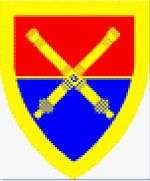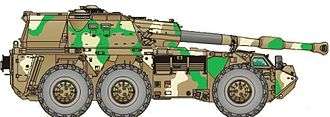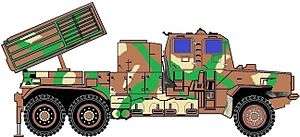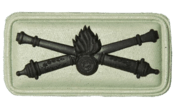School of Artillery (South Africa)
| School of Artillery | |
|---|---|
 | |
| Active | 1934 – current |
| Country |
|
| Branch |
|
| Role | Artillery training school |
| Part of | South African Army Artillery Formation |
| Garrison/HQ | Potchefstroom 26°40′16″S 27°04′28″E / 26.67099°S 27.07446°ECoordinates: 26°40′16″S 27°04′28″E / 26.67099°S 27.07446°E |
| Motto(s) |
Per Scientiam Vires (Strength through Science) |
| Insignia | |
| Collar Badge | Bursting grenade with seven flames |
| Beret Colour | Oxford Blue |
| Artillery Battery Emblems |
 |
| Artillery Beret Bar circa 1992 |
 |
The School of Artillery is the South African Army's specialized artillery training school
History
Before the establishment of a South African artillery school in 1934[1] there were a number of earlier artillery training establishments. The first was formed at the Cape in August 1786 with Lt. Louis-Michel Thibault, later better known as an architect, as head of the ‘Militaire School’. It did not operate for long.
Almost a hundred years later an artillery school was proposed by Capt W E Giles, Royal Artillery, in a document submitted to the Cape Colonial Government in March 1880. It was not accepted.
On 14 September 1912 when the five regiments of the SA Mounted Rifles were about to be established, a School of Gunnery was opened at Auckland Park, Johannesburg, in the lines of the Transvaal Horse Artillery. Its purpose was to train officers and NCO’s for the first three permanent batteries that were to be established. The school closed down when war broke out in 1914 after only two courses had been completed.
The next artillery training institution was the Artillery Training Depot, established at Wynberg Camp, Cape Town, in August 1915 to train the artillery batteries that fought in East Africa, and later in Palestine.
A corps of South African Artillery was established by proclamation on 1 September 1934 to incorporate all the Permanent and Citizen Force units. And on 7 September the two batteries lost their battery status and were formed into an Artillery Training Depot, armed with 4.5 inch howitzers, 18-pdrs and 3.7 inch howitzers.
The Depot staff was responsible for the training of all artillery recruits and all artillery units, except Cape Field Artillery (CFA), which was the responsibility of the Cape Command Training Depot.
By August 1935 the Artillery Training Depot was organized as a Depot Headquarters with three batteries. And on 24 October 1936 the title was altered to that of ‘Artillery School’. War was declared on 6 September 1939 and with no suitable area near Pretoria for gunnery practice the School moved to Potchefstroom.
During the time the School was at Potchefstroom it underwent various changes of designation and became a unit of the Citizen Force when its title was altered to Artillery and Armoured Corps Training School (V), South African Artillery from 1 January 1944.
When the war was over it was re-established on 14 June 1946 as a Permanent Force unit known as the School of Artillery and Armour. It was housed in the main camp but when 4 Field Training Regiment was formed in 1953 the School moved to the former SA Air Force base below Hospital Hill.
Armour training was moved to Bloemfontein in 1964, and the school became a separate unit known simply as the School of Artillery on 1 February 1964, a name it has since retained.[2]
It was awarded the freedom of Potchefstroom on 10 March 1978.
Training
The School conducts the following training:
Basic Instruction which includes: drill, safety, operation of muzzle loading, procedures for each position of a crew. Students are provided with knowledge of the various artillery systems, knowledge in the areas of observed fire, fire direction, and to manage maintenance.
Advanced Instruction includes: drill, safety, and operation up to battery level. Students are provided with the knowledge of manoeuvre force, target acquisition, survey, and counter-fire. Also included are typical field gunnery problems, fire direction, observed fire, and firing battery operations.
Officers are trained to manage fire direction operations, target acquisitioning, and deployment, in support management, maintenance and supply procedures, as well as communications/electronics. Officers may be eventually utilised as commanders, fire support officers, or fire direction officers.
Instructors Training: Students may also become Instructors in their own right after a period of time in the Formation.
Equipment
Conventional Artillery
| Variant | Description | Comment | Image |
|---|---|---|---|
| G1 Howitzer | 25 pounder, high explosive, anti tank and smoke shells | | |
| G2 Howitzer | 5.5 inch medium gun, high explosive |  | |
| G4 Howitzer | 155mm, high explosive |  | |
| G5 Howitzer | 155mm, high explosive, Samil 100 Gun tractor |  | |
| G6 Howitzer | 155mm, high explosive, Self driven |  | |
Multiple Rocket Launcher Systems
| Variant | Description | Comment | Image |
|---|---|---|---|
| Valkiri MRLS | 127mm rocket MLRS |  | |
| Bateleur MRLS | 127mm rocket MLRS |  | |
Unmanned Aerial Vehicle
| Variant | Description | Comment | Image |
|---|---|---|---|
| Vulture UAV | Vulture unmanned aerial vehicle |  | |
Insignia
Previous Insignia

Current Insignia
Proficiency badges
SA School of Artillery Leadership
| From | Commanding Officers | To |
| 10 December 1963 | Cmdt H.J. Greyvenstein UKLGSC[lower-alpha 1] | 2 October 1966 |
| 3 October 1966 | Cmdt C.L. Viljoen[lower-alpha 2] | 31 January 1968 |
| 1 February 1968 | Cmdt R.F. Brown | 18 December 1968 |
| 19 December 1968 | Col J.D. Potgieter SM | 29 August 1969 |
| 30 August 1969 | Col R.F. Brown | 30 April 1970 |
| 1 May 1970 | Col F.E.C. van den Berg UKLGSC | 14 August 1973 |
| 15 August 1973 | Col J.J. Bisschoff | 29 February 1976 |
| 1 March 1976 | Col P.M. Lombard UKLGSC | 7 January 1980 |
| 8 January 1980 | Col C.F. Wentzel | 31 December 1982 |
| 1 January 1983 | Col J.A. Laubscher | 8 January 1987 |
| 9 January 1987 | Col J.G. Jacobs | 3 January 1991 |
| 4 January 1991 | Col M.A. Schalekamp SM MMM | 30 April 1995 |
| 1 May 1995 | Col T.J. Coetzee HC MMM | 31 December 1998 |
| 1 January 1999 | Col P. Franken MMM | 1 January 2002 |
| 1 February 2002 | Col K. Makina | 1 December 2004 |
| 1 January 2005 | Col T. Zungu | 31 March 2008 |
| 1 April 2008 | Col D.B.J. Schoonwinkel | Present |
| From | Regimental Sergeants Major | To |
| 4 January 1957 | WO1 J.J.D. Nortjé | 2 July 1967 |
| 6 July 1967 | WO1 A.P. Van Den Berg | 30 June 1969 |
| 1 July 1969 | WO1 J.D. Kruger | 31 December 1969 |
| 1 January 1970 | WO1 J.H.J. Willemse PMM | 12 May 1974 |
| 13 May 1974 | WO1 M.T. Terwin | 31 December 1977 |
| 1 January 1978 | WO1 A.E. Hook | 6 December 1980 |
| 7 December 1980 | WO1 D.J. Venter | 31 December 1982 |
| 1 January 1983 | WO1 W.J. Van Coller | 28 February 1984 |
| 29 February 1984 | WO1 C.J. Badenhorst | 30 April 1987 |
| 1 May 1987 | WO1 A.E. Hook (Jnr.) | 3 January 1991 |
| 4 January 1991 | WO1 W.H.S. Collins | 31 December 1994 |
| 4 January 1995 | WO1 J.A. Boulter | 31 December 1998 |
| 1 January 1999 | WO1 J.F. Krüger | 31 December 2000 |
| 1 January 2001 | WO1 X.S. Siphunzi | 11 July 2003 |
| 11 July 2003 | WO1 J. Niemand | 9 January 2005 |
| 10 January 2005 | WO1 P.E. Petersen | 1 November 2008 |
| 1 November 2008 | MWO M.P. Mokoena | n.d |
| 20 December 2016 | MWO J.B. van Zyl | n.d |
Notes and references
- ↑ Anon., "School of Artillery", South African Gunner (PDF), p. 9, retrieved 2015-03-31
- ↑ Englebrecht, Leon (1 February 2013). "South Africa (Order of Battle)". defenceweb.co.za. DefenceWeb. Retrieved 27 October 2014.
- ↑ "The Vulture UAV". Paramount Group. 2012. Retrieved 2015-04-01.


